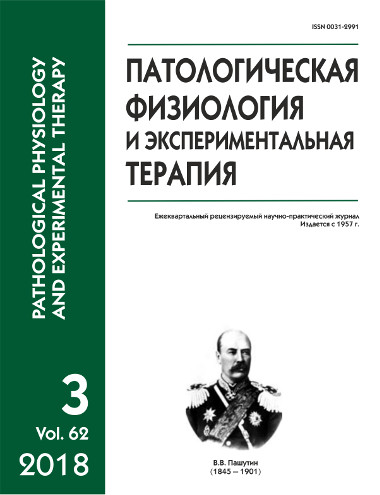Reparative processes in allo- and xenoimplantation of extracellular bone matrix
Abstract
The need for bone-plastic material is presently rapidly increasing, particularly for reconstructive and restorative surgeries on bone tissue in traumatology and orthopedics, maxillofacial surgery, bone oncology, and other cases of surgical practice. Among the implantation materials based on bone tissue the leading place is occupied by auto- and allogeneic implants. Autogenic implants are the best from the biological point of view but xenobone materials are their worthy alternative due to their availability and biocompatibility. The aim of this research was to study reparative processes in the regeneration zone during allo- and xenoimplantation of a material obtained from bone tissue into a semicircular defect in the rat femoral diaphysis. The materials were prepared using the same technology. Methods. Biochemical and morphological studies were performed on 18 male Wistar rats aged 6—8 months. The rats were divided into 3 groups. The first group (n = 6), xenoimplantation; the second group (n = 6), alloimplantation, and the third group, healthy control (n = 6). On the 60th day of experiment, biochemical indexes of blood serum were studied, including activities of total alkaline phosphatase (TCA) and tartrate-resistant isoenzyme of acid phosphatase (TrAP), calcium, phosphate, total protein (TP), C-reactive protein, protein fractions, and morphological studies. Results. Measuring serum protein fractions and C-reactive protein showed the absence of a significant inflammatory reaction to allo- and xenoimplantation of extracellular bone matrix into the defect of femoral metaphysis. Activation of reparative process was noted in both experimental groups. Histological analysis found osteointegration of both allogeneic and xenogenic fragments of the spongy bone implanted into the semicircular defect of rat femur. When alloimplants were used a high rate of their biodegradation and organotypic remodeling of the operated recipient’s bone were observed. However, in all cases, there was no evidence of a rejection reaction, encapsulation of the implant or inflammation in tissues of the maternal bed. The study produced biochemical and histological evidence supporting for a possible use of extracellular matrix of xenogeneic nature for replacement of bone tissue defects.
Downloads
References
2. Ogorodova L.M. Report: The growing role of implants and minimally invasive surgery in the development of modern medicine. http://2013.forinnovations.ru/_src/ForumEvents.Report/40_file/64 62_oiforum2013_ludmila_ogorodova.pdf (reference date: 10.10.2016). (in Russian)
3. Kirilova I.A., Sadovoj M.A., Podorozhnaja V.T. Comparative characteristics of materials for bone plasty: composition and properties. Hirurgiya pozvonochnika. 2012; (3): 72-83. (in Russian)
4. Saveljev V.I. Experience in the manufacture and use of demineralized bone tissue in an experiment and clinic. [Opyt izgotovleniya i primeneniya demineralizovannoy kostnoy tkani v ehksperimente i klinike. Biomeditsinskie tekhnologii]. Sb.nauch.tr. NIC BMT. Moscow; 2001; (17): 17- 24. (in Russian)
5. Bauer T.W. Bone graft materials. Clin. Orthop. 2000; (371): 10-27.
6. Iwata H. Demineralized bone matrix and native bone morphogenetic protein in orthopaedic surgery. Clin. Orthop. 2002; (395): 99-109.
7. Oakes D.A. An evaluation of human demineralized bone matrices in a rat femoral defect model. Clin. Orthop. 2003; (413): 281-90.
8. Talashova I.A., Silantjeva T. A., Kononovich N.A., Luneva S.N. Biocompatibility of calcium phosphate materials of biogenic origin in implantation at bone defects of dogs. Zhurnal klinicheskoy I eksperimental’noy ortopedii im. G.A. Ilizarova Geniy ortopedii. 2016; (4): 95-10. (in Russian)
9. Talashova I.A. Silantjeva T. A. Qualitative and quantitative composition of implantation calcium phosphate materials. Uspekhi sovremennogo estestvoznaniya. 2007; (11): 15-9. (in Russian)
10. Belova S.V., Norkin I.A., Puchin’yan D.M. Influence of biopolymer chondroitin sulfate on reparative regeneration of connective tissue. Patologicheskaya fiziologiya i ehksperimental’naya terapiya. 2015; 59 (1): 76-9. (in Russian)
11. Nakoskin A.N., Djurjagina O.V., Kovinka M.A. Xenoimplantation of the matrix of bone tissue in bone defects replacement in rabbits. Veterinariya Kubani. 2016; (6): 19-21. (in Russian)
12. Ter-Asaturov G.P., Lekishvili M.V., Bigvaeva A.T. et al. A comparative experimental morphological study of the biological osteoplastic materials efficiency in the replacement of bone defects. Kletochnaya implantologiya i tkanevaya inzheneriya. 2012; (1): 81-85. (in Russian)
13. European Convention for the protection of vertebrate animals used for experimental and other scientific purposes. Voprosy rekonstruktivnoy i plasticheskoy khirurgii. 2003; (4): 34-36; 2004. (1): 20-36; (2): 29-31. (in Russian)
14. Sarkisov D.S. Microscopic technology: guide for doctors and laboratorians. [Mikroskopicheskaya tekhnika: rukovodstvo dlya vrachey i laborantov]. Moscow; Meditsina; 1996. (in Russian)
15. Gajdyshev I.P. Solution of scientific and engineering tasks using Excel. VBA i C/C++. [Reshenie nauchnykh i inzhenernykh zadach sredstvami Excel. VBA i C/C++]. Sankt Peterburg Spb: BHV — Peterburg; 2004. (in Russian)
16. Tushina N.V., Talashova I.A, Kononovich N.A., Popkov A.V. Biochemical markers of inflammation in dogs during lengthening of shin bones by Ilizarov. Uspekhi sovremennogo estestvoznaniya. 2015; (8): 48-52. (in Russian)
17. Nakoskina N.V., Nakoskin A.N. Biochemical criteria of regeneration and energy supply in blood serum during experiment with local injection of bone extracts to the fracture zone. Uspehi sovremennogo estestvoznaniya. 2015; (9-2): 219-22. (in Russian)






